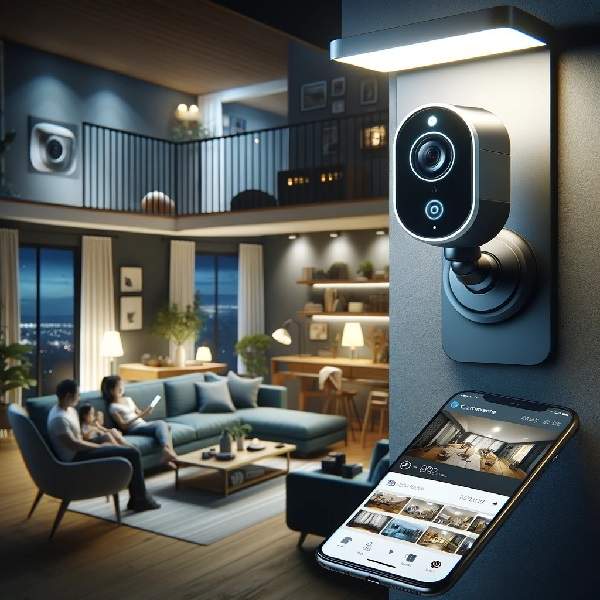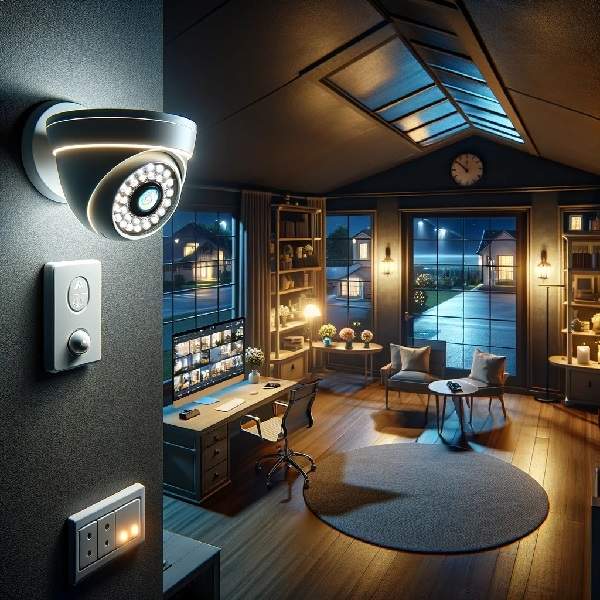Smart Surveillance has emerged as a cutting-edge solution in residential security, making a significant difference in how we protect our homes against external and internal threats. This technology, which fuses innovation and security, not only promises peace of mind but redefines what spy cameras mean for keeping a personal or work space safe. Below, we will explore this concept in depth, elucidating its definition, the evolution of security systems that have facilitated its emergence and its importance in today's context.

Introduction to Intelligent Surveillance
Smart Surveillance represents the next level in the evolution of home security, where advanced technology and connectivity come together to offer proactive, rather than reactive, security solutions. This new era of security combines real-time monitoring with predictive analytics, providing not only surveillance but also operational intelligence to prevent incidents before they occur.
Definition of Intelligent Surveillance
Intelligent Surveillance is a term that encompasses the use of security systems and devices equipped with artificial intelligence (AI) capabilities, machine learning and big data analytics to anticipate potential threats and act preemptively. These systems can include everything from smart security cameras to advanced motion sensors, all connected through an intelligent network that analyzes and manages information in real time.
The fundamental difference between traditional surveillance and smart surveillance lies in the latter's ability to learn from the data collected, adapting and continuously improving its efficiency. This means that the more these systems are used, the more accurate and effective they become in identifying anomalous behavior or potentially dangerous situations.
Evolution of Safety Systems
To understand the importance of intelligent monitoring, it is essential to look back and see how we got here. Security systems have evolved from simple alarms and locks to complex integrated camera and sensor systems. This evolution has been driven by technological advances, but also by a growing need for more robust and adaptive security solutions.
In this journey, intelligent surveillance stands as the pinnacle of security innovation, marking a transition from passive systems, which merely record events, to active systems, which anticipate and prevent risks. This paradigm shift reflects a more holistic and dynamic approach to security, where prevention and adaptability are fundamental.
Importance of Intelligent Protection Today
The relevance of intelligent protection today cannot be underestimated. In a world where security threats are becoming increasingly sophisticated and varied, having systems in place that can anticipate and neutralize risks is imperative. Intelligent surveillance offers just that: an additional layer of security that is both proactive and reactive.
Moreover, in the context of an increasingly connected society, smart protection aligns perfectly with modern security expectations. Users are looking for solutions that not only protect their physical assets but also provide peace of mind. The ability of these systems to provide real-time alerts and act automatically in the event of incidents represents a quantum leap in how we conceive of home security.
How Automated Monitoring Works
Automated Supervision stands as a security fortress, offering not just surveillance, but intelligent, proactive protection. Its operation is based on advanced analytics, comprehensive connectivity and unprecedented responsiveness. Below, we will explore the technologies that enable this advanced system, how they integrate with each other for complete protection, and how they analyze and respond to situations in real time.
Key Technologies in Intelligent Observation
Intelligent Observation systems are equipped with a variety of technologies that enable them to sense, learn and act. Among these, Artificial Intelligence (AI) and Machine Learning are fundamental, allowing the devices not only to capture information from the environment, but also to interpret and learn from it. This translates into an ability to distinguish between normal and potentially dangerous behavior, adjusting their responses accordingly.
Smart cameras, for example, not only record what is happening, but can identify human figures, read license plates or even detect suspicious behavior thanks to real-time video analysis. Motion sensors become more accurate in differentiating between pets and people, reducing false alarms and increasing the effectiveness of surveillance.
In addition, facial recognition technology adds another layer of security, enabling highly secure access systems that can differentiate between residents and strangers, offering unprecedented access management that is tailored to the specific needs of each home.
Systems Integration and Connectivity
A distinguishing feature of Automated Surveillance is its ability to seamlessly integrate with other systems within the home, creating an interconnected security network. This integration is achieved through IoT (Internet of Things) connectivity, which allows devices of different types to communicate and collaborate with each other.
This interconnection facilitates scenarios where, for example, a camera detects unusual motion and can automatically turn on lights, record video and send alerts to the homeowner, all without human intervention. The integration also enables remote control of security systems through mobile apps, giving users the ability to monitor and manage their home security from anywhere.

Automated Analysis and Response
The core of Intelligent Surveillance lies in its ability to analyze information in real time and make decisions autonomously. Thanks to advanced analytics, these systems can predict anomalous behavior and respond immediately, either by alerting homeowners, contacting authorities or activating specific security measures such as automatic locks or alarm systems.
This automated response capability ensures that, even in the absence of the homeowners, the home remains protected against any eventuality, from intrusion attempts to emergency situations such as fire or flooding. Intelligent Surveillance not only acts as an effective deterrent against criminals, but also provides rapid mobilization of resources to mitigate any damage or loss.
3. Choosing and Installing your Automated Surveillance System
The implementation of an Automated Surve illance system represents a fundamental step towards residential security and safety. However, the selection and installation of such systems requires careful consideration to ensure that they meet the specific needs of each home and provide optimal coverage.
Identifying Specific Needs
Before selecting a Smart Surveillance system, it is essential to assess the specific needs of your home. This includes considering the size of the property, key entry points, internal and external areas that require monitoring, and the security particularities that each family may have. Understanding these factors will ensure that the chosen system provides complete coverage, leaving no vulnerable areas unprotected.
In addition, it is important to contemplate the advanced features desired, such as facial recognition, integration with other smart home devices, or automatic notification and response capabilities. These preferences should align with the goal of creating a secure and controlled environment.
Selecting the Right System
Once the needs have been identified, the selection of the right Intelligent Surveillance system is crucial. It is advisable to opt for systems that offer high image quality, extensive detection capabilities, and compatibility with other intelligent devices. Artificial Intelligence and Machine Learning are desirable features, as they allow systems to adapt and continuously improve their threat detection effectiveness.
Seeking reputable brands and vendors that offer technical support and software updates is also critical to ensure system longevity and efficiency. Investing in a quality Smart Surveillance system is an investment in the long-term security and peace of mind of your home.
Installation and Configuration Process
Proper installation and configuration are as important as the selection of the system itself. Depending on the complexity of the system, it may be advisable to hire professionals to ensure proper installation. This ensures that all components are properly positioned and configured for optimum efficiency and coverage.
Initial configuration should include customizing settings to user preferences, such as activation schedules, sensor sensitivity levels and notification settings. Integration with other smart home devices should also be considered, allowing centralized management and control through a single interface.
Why Choose ESPIAMOS for your Security?
After understanding the importance of Smart Surveillance and how to implement it properly, a fundamental question arises: where to find a system that meets all these expectations? The answer is simple: ESPIAMOS.
ESPIAMOS stands out in the security market for its commitment to innovation, quality and customer satisfaction. Our selection of Intelligent Surveillance systems not only meets the most demanding technical requirements, but also aligns perfectly with the values of security, trust and business ethics.
Frequently Asked Questions About Intelligent Surveillance
When considering the implementation of Smart Surveillance in the home or in a business environment, it is common for questions to arise about how these systems advance security and convenience. Below, we answer some of the most common concerns to provide further insight into these cutting-edge systems.
-
What characterizes Smart Surveillance versus traditional surveillance? Smart Surveillance incorporates advanced technologies such as artificial intelligence (AI) and machine learning to analyze captured video and audio in real time. Unlike traditional surveillance, which relies on human observation, these systems can identify patterns, detect unusual movements, and send automatic alerts, significantly improving efficiency and response to security events.
-
How does Intelligent Monitoring contribute to improving home security? These systems can continuously monitor without the need for human intervention, detect suspicious behavior, recognize known faces, and send real-time alerts to homeowners or law enforcement. This proactive surveillance helps prevent incidents before they occur.
-
Are Smart Surveillance systems difficult to install? The complexity of installation varies by system. Some products are designed to be easily installed by the user, offering intuitive interfaces and step-by-step guides. Other more complex systems may require professional installation to ensure optimal configuration.
-
Can Advanced Surveillance systems invade privacy? While Intelligent Surveillance offers numerous benefits in terms of security, it also raises questions about privacy. It is important to choose systems that comply with local data protection laws and configure them in a way that respects the privacy of individuals, limiting monitoring to public or privately owned areas with proper consent.
-
Is it necessary to have an Internet connection to use Automated Surveillance? While some systems can operate to a limited degree without an Internet connection, most advanced functionality such as remote access, real-time alerts and software updates require a stable Internet connection.
-
What maintenance do these systems require? Automated Surveillance systems generally require little maintenance. It is advisable to perform periodic checks to ensure that the cameras and software are functioning properly and to update the systems when necessary.
-
How can I make sure my Advanced Monitoring system is secure against hackers? It is vital to choose systems with robust security measures, such as data encryption, two-factor authentication and strong passwords. Keeping system software up to date and changing passwords regularly are best practices to protect your system from unauthorized access.
-
Can Intelligent Control differentiate between a real threat and a false alarm? One of the main advantages of Smart Control is its ability to analyze behavior patterns and distinguish between normal activities and potential threats, significantly reducing the number of false alarms compared to traditional surveillance systems.
-
What should I consider when choosing an Automated Security system? Evaluate your specific security needs, the size and characteristics of the space to be monitored, and your budget. Consider systems that offer the flexibility to add additional cameras, have a user-friendly interface, and provide remote access to monitor your property from anywhere.






 WhatsApp
WhatsApp Telegram
Telegram


